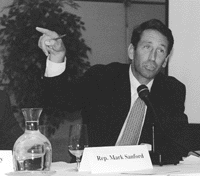Fall 1998
Social Security: Up for Grabs
Did you know that:
These are just some of the facts and myths that came to light at the Pew Center workshop for journalists, “Social Security: Up for Grabs,” Sept. 11 and 12 in Washington, D.C.
The single-issue workshop was a new experiment for the Pew Center, which usually focuses on meaningful coverage of diverse community issues.
“This is the first time the center has ever done a workshop on a single issue. . .
“We’ve learned from surveys and conversations around the country that the public is really confused about Social Security – and that the media is a part of the problem. So, we asked: Can the media also be a part of the solution?”
“I don’t believe we have a crisis in Social Security,” said luncheon keynoter, E.J. Dionne, author and Washington Post columnist. “We have a problem.”
He encouraged the journalists to think of Social Security not as an entitlement program, but as a social insurance program that also covers the disabled and widows and orphans.
|
|
|
|
| Journalists Bob Rosenblatt, Los Angeles Times; Tom Still, Wisconsin State Journal; Maureen West, Arizona Republic; and Steve Scher; Seattle's KUOW-FM, shared story ideas and warned of coverage pitfalls. Reformers, including U.S. Reps. Mark Sanford and Earl Pomeroy and the Brooking's Henry Aaron, advance their ideas. |
 |
|
|
And he cautioned them to beware of journalists' tendency to have an educated, upper middle-class bias that might affect their coverage of reform proposals. "Reporters don't like gradualism solutions because it makes it harder to get their stories into the paper," he said.
Social Security Commissioner Ken Apfel walked the group through the demographic realities, some of the numbers and several of the reform options. Carolyn Lukensmeyer, director of American Discuss Social Security, which co-sponsored the workshop, walked journalists through the same values exercise that citizens do in her citizens' forums.
Pollster G. Evans Witt shared a key disconnect between many of the reform proposals and citizens' views: Nearly three-quarters of Americans polled oppose raising the retirement age to 70, a key element of many reform proposals.
Journalists heard what made the 1983 reform environment different from today's and they learned about the various reform ideas from U.S. Reps. Mark Sanford (R-SC) and Earl Pomeroy (D-ND), the Brookings Institution's Henry Aaron, and Sam Beard, President of Economic Security 2000.
From the journalists came story ideas and advice:
"Washington questions are important," said Tom Still, associate editor of the Wisconsin State Journal, "but they are not the kinds of questions we hear from our citizens. They want to know: Is Social Security still a good deal?"






